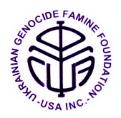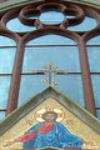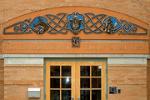It's a ...Ukrainian thing
Daily Herald Newspaper
Posted Tuesday, February 22, 2005
Ukrainian Easter eggs: While every Ukrainian family has attempted to make pysanky, or Ukrainian Easter eggs, it takes a skilled artist to make the truly prized
eggs.
"You take an (emptied) egg, then fill up a kistka (a tool) with beeswax and apply it to the egg," says Natalia Mischenko, of Palatine. "That holds the white part. You dip
into yellow food coloring, and it's a process of going from the lightest to the darkest color."
The Ukrainian National Museum, 2305 W. Superior St., Chicago, has fine examples of Easter eggs, as well as folk art and folk musical instruments such as the
bandura, pictured.
Lessons of the past: Katya Mischenko-Mycyk, Nick's younger daughter, testified to an Illinois House committee in Springfield 13 days ago. She and
her dad, who is president of the Ukrainian Genocide Famine Foundation, are championing a bill that would require Illinois schools to teach about
genocides in Ukraine, Armenia, Cambodia, Bosnia, Rwanda and Sudan.
Katya's testimony described how, during the winter of 1932-33, Ukrainian peasants died at the rate of 25,000 a day from starvation. This happened
even as Soviet Premier Joseph Stalin dumped on Western markets a fifth of a ton of grain for every peasant that died. Survivors were too weak to bury
corpses in the frozen ground, so towering piles of the dead could be found near most rural villages.
Many Americans have never heard of the Ukrainian famine for two reasons: At the time, the Soviet Union sealed Ukraine's borders and, even though a
few reports of a famine leaked out, Soviet sources denied them.
For the remainder of the Soviet Union's existence, those who spoke about the famine could be punished. Even after Nick's father-in-law came to
Chicago, he was afraid to talk about it for fear the USSR would exact retribution on his relatives in Ukraine.
A religion primer: Ukrainians belong to a variety of Christian churches, including the Ukrainian Orthodox Church and the Ukrainian Catholic Church of the Greek
rite.
"At one time all of Ukraine was Orthodox, but the Poles (when they ruled) forced the Catholic church on Ukrainians. They wanted to make them Roman Catholics, but
they settled for Greek," Nick explains.
The Mischenkos attend an Orthodox church, St. Volodymyr Ukrainian Orthodox Cathedral in Chicago's Ukrainian Village.
"It's typical for suburban Ukrainians to go to church every Sunday in Ukrainian Village," Nick says.
However, active congregations also attend Immaculate Conception Ukrainian Byzantine Catholic Church in Palatine and St. Andrew Ukrainian Orthodox Church in
Bloomingdale.
Most Ukrainians feel the difference between churches in the calendar. Orthodox Christians and Greek rite Catholics celebrate Christmas Jan. 7, while Roman Catholics
celebrate it Dec. 25. This year, Roman Catholics will celebrate Easter March 26 while Orthodox Christians and Greek rite Catholics celebrate it May 1.
The importance of icons: Before Katya Mischenko married George Mycyk, who is also Ukrainian American, in May 2003, the bride's family gave them
wedding icons. Icons are sacred paintings of holy figures.
Following tradition, the starosto and starosta (male and female elders) held the couple's icons during the wedding ceremony. The bride and groom kissed the icons three
times. At the reception, they displayed the icons with the traditional Ukrainian wedding bread, called korovaijs.
"Ukrainians say that the eyes of the saints in the icons are 'windows into heaven' and that is why we pray through icons and we always keep them in our homes," says
Katya, who lives in Chicago. "I think to many Christian Ukrainians their most valuable 'material' possessions on earth are their icons and the cross with which they were
christened as babies."
- Pam DeFiglio, Daily Herald Staff Reporter
Daily Herald Newspaper
Posted Tuesday, February 22, 2005
Ukrainian Easter eggs: While every Ukrainian family has attempted to make pysanky, or Ukrainian Easter eggs, it takes a skilled artist to make the truly prized
eggs.
"You take an (emptied) egg, then fill up a kistka (a tool) with beeswax and apply it to the egg," says Natalia Mischenko, of Palatine. "That holds the white part. You dip
into yellow food coloring, and it's a process of going from the lightest to the darkest color."
The Ukrainian National Museum, 2305 W. Superior St., Chicago, has fine examples of Easter eggs, as well as folk art and folk musical instruments such as the
bandura, pictured.
Lessons of the past: Katya Mischenko-Mycyk, Nick's younger daughter, testified to an Illinois House committee in Springfield 13 days ago. She and
her dad, who is president of the Ukrainian Genocide Famine Foundation, are championing a bill that would require Illinois schools to teach about
genocides in Ukraine, Armenia, Cambodia, Bosnia, Rwanda and Sudan.
Katya's testimony described how, during the winter of 1932-33, Ukrainian peasants died at the rate of 25,000 a day from starvation. This happened
even as Soviet Premier Joseph Stalin dumped on Western markets a fifth of a ton of grain for every peasant that died. Survivors were too weak to bury
corpses in the frozen ground, so towering piles of the dead could be found near most rural villages.
Many Americans have never heard of the Ukrainian famine for two reasons: At the time, the Soviet Union sealed Ukraine's borders and, even though a
few reports of a famine leaked out, Soviet sources denied them.
For the remainder of the Soviet Union's existence, those who spoke about the famine could be punished. Even after Nick's father-in-law came to
Chicago, he was afraid to talk about it for fear the USSR would exact retribution on his relatives in Ukraine.
A religion primer: Ukrainians belong to a variety of Christian churches, including the Ukrainian Orthodox Church and the Ukrainian Catholic Church of the Greek
rite.
"At one time all of Ukraine was Orthodox, but the Poles (when they ruled) forced the Catholic church on Ukrainians. They wanted to make them Roman Catholics, but
they settled for Greek," Nick explains.
The Mischenkos attend an Orthodox church, St. Volodymyr Ukrainian Orthodox Cathedral in Chicago's Ukrainian Village.
"It's typical for suburban Ukrainians to go to church every Sunday in Ukrainian Village," Nick says.
However, active congregations also attend Immaculate Conception Ukrainian Byzantine Catholic Church in Palatine and St. Andrew Ukrainian Orthodox Church in
Bloomingdale.
Most Ukrainians feel the difference between churches in the calendar. Orthodox Christians and Greek rite Catholics celebrate Christmas Jan. 7, while Roman Catholics
celebrate it Dec. 25. This year, Roman Catholics will celebrate Easter March 26 while Orthodox Christians and Greek rite Catholics celebrate it May 1.
The importance of icons: Before Katya Mischenko married George Mycyk, who is also Ukrainian American, in May 2003, the bride's family gave them
wedding icons. Icons are sacred paintings of holy figures.
Following tradition, the starosto and starosta (male and female elders) held the couple's icons during the wedding ceremony. The bride and groom kissed the icons three
times. At the reception, they displayed the icons with the traditional Ukrainian wedding bread, called korovaijs.
"Ukrainians say that the eyes of the saints in the icons are 'windows into heaven' and that is why we pray through icons and we always keep them in our homes," says
Katya, who lives in Chicago. "I think to many Christian Ukrainians their most valuable 'material' possessions on earth are their icons and the cross with which they were
christened as babies."
- Pam DeFiglio, Daily Herald Staff Reporter
Designed and Maintained by
UGFF - USA, Inc. 2008
UGFF - USA, Inc. 2008
| Ukrainian National Museum Ukrainian Village Chicago, IL |
| Ukrainian Village Chicago, IL |


